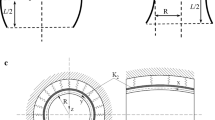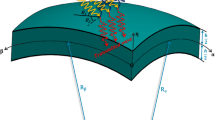Abstract
The turtle shell is an amazing structure optimized through the long-term evolution by nature. This paper reports the mechanical response of the shell (Red-ear turtle) to static and dynamic loads, respectively. It is found that the turtle shell under a compressive load yields the maximum vertical displacement at the rear end, but the vertical displacement at the front end is only half of that at the rear end. The maximum horizontal displacement of the shell also occurs at the rear end. It is believed that such a deformation pattern is helpful for protecting the turtle’s internal organs and its head. The principal stress directions in the inside surface of the shell under a compressive load are almost the same as those of the biofiber distribution in the inside surface, which results in the strong bending resistance of the turtle shell.
Similar content being viewed by others
References
Rieppel O, Reisz R R. The origin and early evolution of turtles. Annual Review of Ecology and Systematics, 1999, 30, 1–22.
Burke A C. The development and evolution of the turtle body plan: Inferring intrinsic aspects of the evolutionary process from experimental embryology. American Zoologist, 1991, 31, 616–627.
Gaunt A S, Gans C. Mechanics of respiration in the snapping turtle, Chelydra serpentina (Linné). Journal of Morphology, 1969, 128, 195–227.
Lee M S Y. Correelated progression and origin of turtles. Nature, 1996, 379, 811–815.
Carr A F. Handbook of Turtles: The Turtles of the United States, Canada, and Baja California, Comstock Pub Associates, Ithaca, New York, 1952.
Cebra-Thomas J, Tan F, Sistla S, Estes E, Bender G, Kim C, Riccio P, Gilbert S F. How the turtle forms its shell: A paracrine hypothesis of carapace formation. Journal of Experimental Zoology B, 2005, 304, 558–569.
Jackson D C. How a turtle’s shell helps it survive prolonged anoxic acidosis. News in Physiological Sciences, 2000, 15, 181–185.
Domokos G, Varkonyi P L. Geometry and self-righting of turtles. Proceedings of the Royal Society B, 2007, 275, 11–17.
Rivera A R V, Rivera G, Blob R W. Kinematics of the righting response in inverted turtles. Journal of Morphology, 2004, 260, 322.
Zhou Y J, Zhang W Z, Yuan Y P, Cheng X G. Load bearing behavior of turtle shell structure and its applications. Journal of Machine Design, 2006, 23, 37–40. (in Chinese)
Rhee H, Horstemeyer M F, Hwang Y, Lim H, EI Kadiri H, Trim W. A study on the structure and mechanical behavior of the Terrapene carolina carapace: A pathway to design bio-inspired synthetic composites. Materials Science and Engineering C, 2009, 29, 2333–2339.
Xu Y D, Zhang L T. Mechanical property and microstructure of tortoise shell. Acta Materiae Compositae Sinica, 1995, 12, 53–57. (in Chinese)
Zhang W, Wu C W, C Z Zhang, Chen Z. Microstructure and mechanical property of turtle shell. Theoretical & Applied Mechanics Letters, 2012, 2, 014009.
Krauss S, Monsonego-Ornan E, Zelzer E, Fratzl P, Shahar R. Mechanical function of a complex three-dimensional suture joining the bony elements in the shell of the red-eared slider turtle. Advanced Materials, 2009, 21, 407–412.
Dai S L, Wang B. Experimental study of human body vibration mode. Mechanics in Engineering, 1996, 18, 19–22. (in Chinese)
Yu Z S. Automobile Design Theory, Mechanical Industry Press, Beijing, China, 2000. (in Chinese)
Choi S B, Han Y M. Vibration control of electrorheological seat suspension with human-body model using sliding mode control. Journal of Sound and Vibration, 2007, 303, 391–404.
Kitazaki, S, Griffin M J. Resonance behaviour of the seated body and effecys of posture. Journal of Biomechanics, 1998, 31, 143–149.
Author information
Authors and Affiliations
Corresponding author
Rights and permissions
About this article
Cite this article
Zhang, W., Wu, C., Zhang, C. et al. Numerical study of the mechanical response of turtle shell. J Bionic Eng 9, 330–335 (2012). https://doi.org/10.1016/S1672-6529(11)60129-7
Published:
Issue Date:
DOI: https://doi.org/10.1016/S1672-6529(11)60129-7




